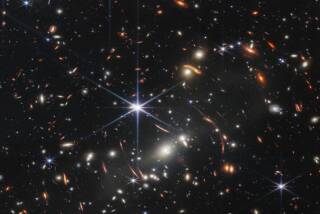Looking Younger : Astronomy: Data from the Hubble Space Telescope supports recent findings that the cosmos is far newer than scientists thought.
- Share via
Astronomers using the Hubble Space Telescope have produced the most compelling evidence yet that the cosmos is younger than scientists previously thought, calling into question the estimated age of the stars and the Big Bang theory itself.
Their calculations, made public Wednesday, are significantly more accurate and broader in scope than two other recent estimates of the age of the universe. Taken together, all three studies strongly suggest that the expanding fabric of the universe--that void between the stars and galaxies--may be considerably younger than the stars themselves.
An international team of 22 scientists, led by Pasadena astronomer Wendy L. Freedman at the Observatories of the Carnegie Institution and Barry F. Madore at Caltech, used NASA’s orbiting telescope and a special camera designed at the Jet Propulsion Laboratory to determine just how fast the universe is expanding with unprecedented accuracy.
That allowed them to determine that the universe is between 8 billion and 12 billion years old. This contrasts with more conventional estimates, based on the age of stars and less precise measurements of intergalactic distances, which range from 16 billion to 20 billion years old.
While the work has Hubble scientists celebrating, the new calculations are beginning to create a major headache for cosmologists. The Hubble study, combined with the most precise measures available from ground-based observatories, apparently indicates there is a possibility that the way scientists view the universe is somehow flawed.
Are the ages of the stars too high? Is there an unexplained force at work to accelerate matter in the cosmos? Or is the Big Bang theory itself incorrect?
“There appears to be a controversy growing here,” said UC Berkeley astronomer Alexi V. Filippenko. If the current results are confirmed and refined through additional observations, “then we will really have a dilemma,” he said.
“It might lead to a revolution in cosmology which would be a very very exciting thing,” Filippenko said. “We may have to consider some new perhaps wild ideas. Maybe there is another force pushing the universe out or something like that. That’s exciting. That’s what science is all about.”
Freedman’s team used the space telescope to develop the most precise yardstick yet for measuring the size, scale and age of the universe by determining the distance from Earth to a distant spiral galaxy called M100.
Through the lens of its recently refurbished Wide Field/Planetary Camera, they scanned 40,000 stars to locate 20 rare pulsating cepheid guide stars in M100, located in the Virgo cluster. Astronomers can use the variable stars to estimate the distance from Earth to the dense stellar cloud. It is the most distant galaxy in which the cepheid variable stars have been detected.
“The speed at which they pulsate reveals their distance,” Freedman said. “The trick is to find them.” The stars are so distant and so faint that “only space telescope can make these types of observations routinely.”
The accurate measurement of the distance to M100--56 million light-years--allowed them to calculate the velocity at which the universe is expanding, called the Hubble constant, which is a measure of how the universe has grown since the primordial Big Bang. That expansion was discovered by astronomer Edwin Hubble, for whom the orbiting telescope is named.
The NASA team’s calculations, published today in the journal Nature, indicate that the universe is expanding so fast that a galaxy about 1 million light-years away will appear to be receding from Earth at approximately 60,000 m.p.h. If it is twice that distance, it will appear from Earth to be moving at twice that speed. The galaxy M100 is receding at a speed of about 3 million m.p.h.
“This galaxy is the most distant object that anyone ever expected (the) space telescope to be able to get to, and it was dead easy,” Madore said. “Now we know we can do Virgo. And in fact it was so easy we know we can go three times farther than Virgo. The space telescope is working at a level that is unprecedented, unexpected and beyond specification.”
The researchers emphasized that although the current assessment of the Hubble constant and the universe’s age is the most carefully calculated to date, they still have at least three years of additional work with the space telescope before they will have an answer they consider definitive.
“The Hubble constant has been fraught with controversy for some time,” said John P. Huchra, a Harvard University astronomer on the Hubble team. “There are also other forces that affect the way galaxies move and we have to work on that as well.”
The speed at which the galaxies recede, for example, is “modified, twisted and warped” by the force of gravity in ways not yet well understood, he said. Without knowing exactly how much matter the universe contains, scientists can only guess as best they can how gravity affects the rate at which the universe is expanding.






